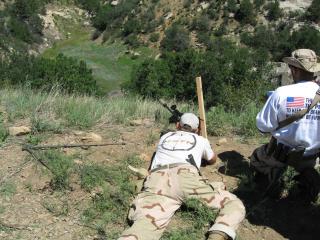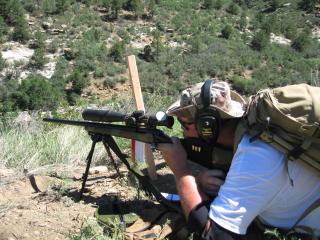Engagement and Follow-Up
While minimizing natural body movements, break the shot with a good sight picture. Maintain a sight
picture through recoil, and, if you've done everything right, you should see the bullet impact the
target. If yes, that's great. Even if you have hit the target, don't forget that you can get
information from the hit. If it's left or right, you get some information about the actual wind
condition compared to your wind call. If it's high or low, it means your load is shooting faster or
slower than you thought, or that the target is closer or further than you thought.

 The author spots his own hits and misses and makes corrections, eliminating some shooter/spotter
communication. His team-mate waits to tell him the next target's dope value.
If you missed the target, you should be able to see the miss nearby as a puff of dust. If your drop
data is correct, it will probably be left or right of the target. Use the features in your reticle
to determine the additional correction needed. For example, if I am dialing windage and I see the
miss 1/4 MIL from the desired point of impact by using the mil dots or hashes in the reticle, I
would dial an additional 0.25 mil windage (actually 0.2 or 0.3 since the clicks will be 0.1 each)
and make the follow-up shot.
Every shot throughout the day gives you feedback about wind conditions, and can help you learn how
wind moves throughout the locale. If a single shoot position has 5 targets to engage, with up to one
hit each and no more than 2 rounds fired at any target, it makes sense to shoot the closest ones
first. With unknown wind, you are more likely to get a hit on the close targets, and the hit
location on the target is a indicator of what wind was present. This information can be applied to
further targets, as you step out from near to far.
When you have finished shooting at this position, it is time to reset your elevation knob by turning
it back to zero. This is especially an issue with elevation knobs that turn multiple revolutions,
such as the Leupold M1 and the Nightforce. It is not uncommmon for a shooter with one of these
scopes to forget to dial down to zero after dialing up for a 500+ yard target, and then at the next
shooting position, they are shooting 15 or 30 minutes over the target.
If you are using a scope that has a single-turn elevation knob like the S&B PMII series or the US
Optics EREK, this is less of an issue. Even in this case, however, it's a good idea to dial it back
because then if you are confronted with the need for a "snap" shot within the point-blank range of
your cartridge (a few hundred yards on practical targets), your scope is ready to go.
Shooting / Spotter Communication
It's common to shoot long-range targets with a partner, either as part of a team match (such as the
PRTC or ITRC), as part of training, or even hunting. While shooting with a partner, the efficiency
and accuracy can be improved by divvying up the tasks. For example, while arriving at a shooting
position, the "shooter" can start to get his rifle set up while he looks for targets. At the same

 Efficiency can sometimes mean not unpacking all your crap-- just get down to shooting.
time, the "spotter" can be locating and ranging targets. The spotter can look for wind indicators
and call wind values, so all the shooter has to do is dial elevation, double-check windage, and
shoot. The spotter can help to spot the hit or miss and give correction or hit location
information back to the shooter.
When shooting a rifle I can keep on-target throughout recoil, I have found that I can spot my own
hit or miss, make the correction, and shoot a follow-up shot faster without getting confirmation or
miss information from the spotter. If both shooter and spotter have rifles with good optics and
have pre-ranged targets, it's often helpful for the spotter to use his rifle-scope for spotter the
other guy's shots. He can use the reticle features to call specific miss location, like "3/4 mil
left", instead of saying something more imprecise such as "about one target's width left". If
there are more targets to range and engage, it's faster for the spotter to stay looking through the
LRF so he can immediately confirm range of the next target.
Efficiency
The shooters and teams who win field-style "hike and shoot matches" usually do not run
cross-country, nor do they rush. They move at a brisk pace on an efficient route to the shoot
position. They approach the shoot position knowing what they are going to do. They locate and
range targets deliberately, and engage each target, usually without missing. The key is that
movement is not wasted. This is something that comes with practice, but key places to look for
improvement: movements that do not directly support making the shot; and thought processes and
adjustments which are not needed. For example, your data card should be set up so that you don't
have to do any mental math while in the field.
|